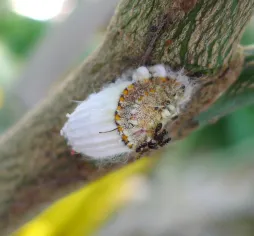Echeveria elegans, a miniature succulent
Echeveria elegans is a succulent native to Mexico. It belongs to the Crassulaceae family. It is distinguished from its cousins, echeveria prolifica and echeveria agavoides, by its small size and color.
How to recognize Echeveria elegans?
Echeveria elegans grows in a rosette and has a compact habit. It grows to between five and ten centimetres tall. As it grows, the plant creates offshoots and can reach a spread of up to 50 centimetres.
Echeveria elegans leaves are fleshy, thick and oval. They end with a tapering point. They feel waxy to the touch. This is due to the bloom that covers them. But this layer is not enough to mask the colors. The green foliage is adorned with silver and bluish hues.
In spring, the plant blooms. The flowers bloom on a fifteen to twenty centimetre stem. Pink and yellow, they are bell-shaped but odorless. After flowering, small brown seeds appear.
If you're looking for a fat plant that's non-toxic to pets and children, Echeveria elegans is for you. Its leaves, sap and flowers present no danger when touched or ingested.
Our maintenance tips
Echeveria elegans are non-hardy succulents. In most regions, they are grown indoors. But this succulent loves the sun. If you have a garden, a balcony or even a windowsill, put it outside in summer. It will appreciate gradual exposure to natural light. However, keep it out of direct sunlight, which can burn the leaves.
Watering
Echeveria elegans come from arid regions. They can withstand drought, but that's no reason to neglect their water supply! If your succulent's leaves point downwards, it's thirsty.
Make sure the substrate is dry before watering. That way, you'll avoid overwatering. Once you've got your watering can, be generous. The plant prefers to be watered less frequently but abundantly than to receive frequent small quantities of water.
Half an hour after watering, remove any stagnant water from the dish. It will rot the roots.
Half an hour after watering, remove any stagnant water from the dish. It will rot the roots.
Spray
Echeveria elegans grow in arid regions and do not like humidity. No need to spray them.
Repotting
Every spring, repot your Echeveria elegans to give it more space.
Choose a pierced terracotta pot two or three centimetres larger than the previous one. Place a bed of gravel or clay balls at the bottom to optimize drainage. Fill to within two or three centimetres of the rim with potting soil for cacti and succulents.
Before repotting your Echeveria elegans, clean it: remove dry leaves from the base and wilted flowers. Make a hole in the center of the pot, using your fingers or a pen, and plant your succulent. All roots should be buried.
Press down to remove air bubbles. You can cover the surface with perlite or sand. This will prevent direct contact between substrate and foliage.
Fertilization
To promote the growth of your Echeveria elegans, apply fertilizer in spring and summer.
Apply a cactus and succulent fertilizer to support growth. Be sure to follow the manufacturer's recommended dosage to avoid damaging the foliage.
Prune
Remove wilted flower stems. Cut flush with a clean, sharp tool (scissors, pruning shears, etc.), taking care not to damage the leaves.
Plantation
When the risk of frost has passed, it's time to plant.
Select a sunny location. If possible, choose a slope or embankment: water will run off more easily and roots will be less likely to rot.
Dig a hole the size of the root ball. Plant your Echeveria elegans in the middle. Fill with a mixture of potting soil and sand. Pack by hand and water to eliminate air pockets.
Cutting
Cutting is carried out during the strong growth phase, generally in spring and early summer.
Remove the shoots that form at the base of the plant with their roots. Proceed delicately, with your hands or a clean knife, to avoid damaging the root system.
Obtain a pierced terracotta pot. This material promotes uniform drying of the substrate and reduces the risk of root rot. Pour a bed of clay balls or gravel in the bottom. If the hole is too large and the marbles escape, fill it with a pebble.
For the substrate, prepare a mixture of one-third soil, one-third potting compost and one-third sand. Line the pot with it. Plant your cutting in the center and press down.
Place your succulent in a room where the temperature doesn't fall below 18 degrees. Find a bright spot away from direct sunlight, behind a curtain for example.
Disease / Threat
Information
| Family | Crassulaceae - Crassulaceae |
| Type | Echeveria - Echeveria |
| Species | Echeveria elegans - Echeveria elegans |
| Lifecycle | Perennial |
| Foliage | Evergreen |
| Exposures | |
| Substrats | |
| Planting methods |
Open ground In pots Planter |
| Categories | |
| Tags |
Beginner Small pot |
| Origin |
Central America |
| Hardiness (USDA) | 9b |
| Leaf color |
|
| Flower colors |
|
| Fruit color |
|
Discover plants from the same family
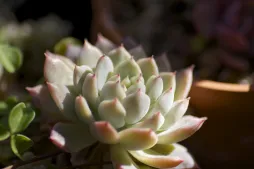
Echeveria prolifica
Discover
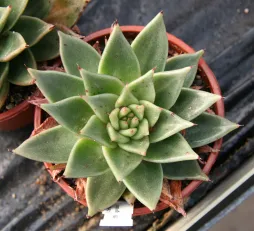
Echeveria agavoides
Discover
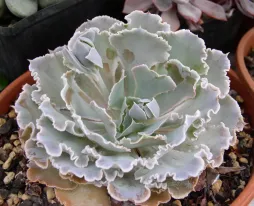
Echeveria shaviana
Discover
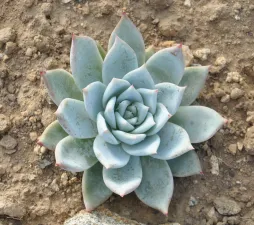
Echeveria colorata
Discover
Find out more
- Echeveria agavoides
- Echeveria prolifica
- 20 easy-to-care-for winter houseplants
- Why do the leaves on my plant have brown tips?
- How to use oyas to water indoor plants?
- Living room, bedroom or bathroom: which houseplant is right for each room?
- How to fertilize indoor plants?
- Non-toxic houseplants for cats, dogs and other pets
- When should houseplants be repotted?













